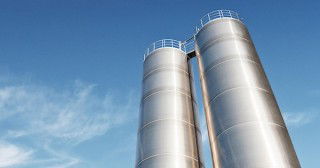Roller presses are a popular choice for raw, pre-clinker or finish grinding. Online condition monitoring of its components can help detect early equipment failure and reduce downtime of the grinding section. By Dalog Diagnosesysteme GmbH, Germany.
Roller presses have proven to be a popular option for new and old cement plants in recent years. When used in a production line upgrade with a ball mill, they increase throughput and energy efficiency.
Roller presses compact the material through two horizontal rolls. One roll is fixed, while the other is connected to a hydraulic system to control the gap between the roller pair (see Figure 1). Each roller has a separate drive system, which consists of a planetary gearbox and an electric motor with variable speed.
Online condition monitoring
Condition monitoring of roller press components allows for effective maintenance planning and repair, thereby minimising downtime as well as preventing unexpected failures and unscheduled stoppages.
The Dalog online condition monitoring system for roller presses detects failures at the motor bearings, gearboxes and grinding rolls at an early stage. It identifies faults by measuring the operational stability with a torque sensor on the input shaft of each drive.
The case studies presented below provide examples of how such a system can help a cement plant detect failure and assist in maintenance preparation.
Case study 1: roller bearing failure
In case study 1, the roller press had been in operation for some years when the maintenance team decided to retrofit an online condition monitoring system to improve predictive maintenance. Seven months after the system’s commissioning, a deviation in the vibration patterns was automatically detected and sent an alarm to the operator.
As well as communicating directly to the distributed control system (DCS), the monitoring system also connects to the Dalog diagnosis centre in Germany, where the case was analysed by Dalog specialists within 24h.
Precise analysis
While the frequency spectrum of the acceleration sensor installed at the roller bearings on the movable side showed no irregularities (Figure 3), the frequency spectrum reading of the roller bearings on the fixed side was quite different (Figure 4). The spectrum showed the ball spin frequency (BSF) and the harmonics of this frequency together with side bands of the shaft speed. The BSF together with the shaft speed is an indication of a bearing roller failure at an early stage.
Dalog diagnosis specialists informed the customer about the failure in the bearing and recommended further action. As a result, the plant maintenance team ordered spare parts and was able to change the damaged bearing during a planned stoppage. Most importantly, this avoided expensive secondary damage.
Case study 2: grinding roller wear detection
Condition monitoring with acceleration sensors is very efficient in early-stage detection, enabling operators to plan maintenance and minimise downtime. However, it is only reactive to an already existing failure. Therefore, how can a plant increase the interval between failures? Process-correlated torque monitoring allows plants to plan maintenance of the grinding rolls to avoid excessive dynamics in the roller press.
In case study 2, following the change of the bearings of the grinding rolls, the plant team was looking for a way to reduce the risk of bearing failure. During mill operation roller surfaces wear down, which results in a higher dynamic load, peaks which exceed the nominal torque and, in general, an instable mill operation and lower performance. In many instances, bearing failures at the rolls are caused by excessive dynamics in the grinding process. The Dalog Torque Sensor D-TS 100 (Figure 6) is a direct measurement system that detects high dynamics, shocks and overloads in the roller press. It then automatically sends alarms to the DCS to inform the operator about these process irregularities.
In this way, the plant maintenance team can plan maintenance, especially on the rolls of the press, according to set limits of the torque, avoiding high dynamics and thus maximising time between equipment failure and the overall life-cycle of the press.
Smooth operation
To reduce excessive loads on the equipment, the maintenance team carried out a hard-facing of the rolls when set limits were passed. As a result, the torque dynamics decreased, giving a smoother and improved operation.
Increasing the interval between failures
Torque monitoring assists in maintenance planning for the grinding rolls to avoid excessive loads and unhealthy machine operations. The plant benefits from longer time between failure of parts, such as gears and bearings.
Improved uptime
Roller presses grind raw materials and cement in a cost-efficient way. However, the highly dynamic process causes excessive stress on the bearings of the grinding rolls and the two drive trains, which ultimately fail and lead to unplanned stoppages. An online condition monitoring system that uses acceleration sensors can help avoid such stoppages.
In addition, an online torque monitoring system that precisely measures the load variation on the machine helps to increase the mean time between failures. Excessive dynamics in the roller press is often related to wear on the rollers, so the trends identified by the torque measurement are a valuable tool when planning an overhaul of such roller presses.
This article was first published in International Cement Review in September 2017.
